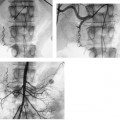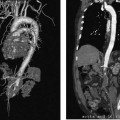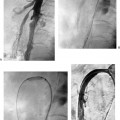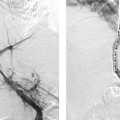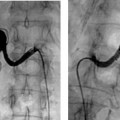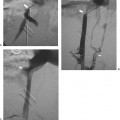CASE 39 A 56-year-old male presented to his primary-care physician complaining of increasing buttock and thigh claudication. On physical exam he was noted to have diminished femoral artery pulses. He was then referred to the interventional radiology section for evaluation and treatment. Figure 39-1 Aortoiliac occlusive disease. (A) Digital subtraction angiogram shows bilateral common iliac artery stenoses. Both common femoral arteries were catheterized using the Seldinger technique, and a 6-French (F) sheath was inserted in the right common femoral artery. A 5F pigtail catheter was advanced into the abdominal aorta to perform pelvic arteriography, which revealed stenoses of both common iliac arteries (Fig. 39-1). Pullback pressure measurements were then obtained across both lesions revealing gradients of 18 mm Hg and 11 mm Hg of the right and left common iliac lesions, respectively. Stenoses of the common iliac arteries. A 6F sheath was inserted via the left common femoral artery puncture. Five thousand units of heparin were administered intra-arterially. The left common iliac stenosis was crossed with a 0.035-inch Bentson guidewire, (Cook, Bloomington, Indiana) and the pigtail catheter entering the right common femoral artery was exchanged over a 0.035-inch guidewire. Bilateral 10- × 60-mm self-expanding stents (Wallstent, Boston Scientific, Natick, Massachusetts) were then advanced over the guidewires to the site of the stenoses identified on angiography and deployed simultaneously (Fig. 39-2A). Deployment catheters were then exchanged for 9- × 20-mm angioplasty balloons, which were used to dilate the stents (Fig. 39-2B). Follow-up arteriography showed rapid antegrade flow through the iliac stents (Fig. 39-2C), and repeat pullback pressure measurements revealed no pressure gradients across the stents. Strong femoral pulses were noted. Puncture needle 6 to 7F vascular sheath 5F pigtail and endhole catheters 0.035″ conventional and hydrophilic soft-tipped guidewires Angioplasty balloon catheters (6 to 12 mm in diameter) Metallic stents and stent grafts (6 to 12 mm in diameter) Intravascular pressure monitor Contrast material Heparin
Clinical Presentation
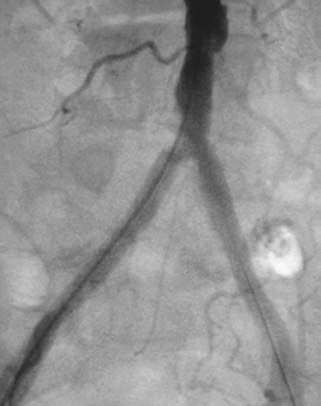
Radiologic Studies
Angiogram
Diagnosis
Treatment
Angioplasty and “Kissing” Stent Insertion
Equipment
Discussion
Background
Stay updated, free articles. Join our Telegram channel

Full access? Get Clinical Tree


